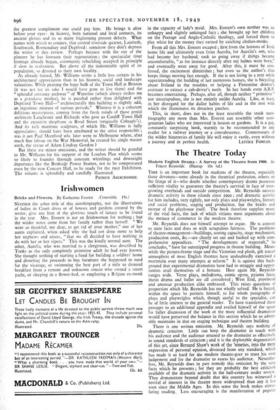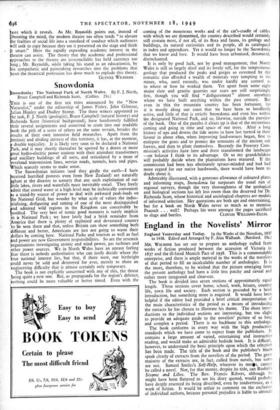The Theatre Today
Modern English Drama : A Survey of the Theatre from 1900. lfv Ernest Reynolds-. (Harrap lOs 6d.) THIS is an important book for students of the theatre," especially those devotees—some already in the theatrical profession, others on the fringe of it—who doubt whether contemporary drama possesses sufficient vitality to guarantee the theatre's survival in face of ever- growing overheads and outside competition. Mr. Reynolds surveys dramatic activity in these islands since 1900 ; and dramatic activity for him includes, very rightly, not only plays and playwrights, literary and social problems, staging and production, but the bricks and mortar of the playhouse itself. The book therefore supplies many of the vital facts, the lack of which vitiates most arguments about the menace of commerce in the modern theatre.
Mr. Reynolds does not •himself attempt to argue. He is content to state facts and does so with scrupulous fairness. The problems of theatre-management—buildings, seating capacity, stage mechanism, production costs, &c.—are clearly set out and backed up with com- prehensive appendices. " The developments of stagecraft," he concludes, " have far outstripped progress in theatre building. Mean- while the picture-frame stage and the Victorian red plush, gilt stucco atmosphere of most English theatres have undoubtedly exercised a mortmain over many attempts at reform." It is against this back- ground that experimental dramatists have had to struggle and oppor- tunists avail themselves of a fortune. Here again Mr. Reynolds ranges wide. Verse plays, melodrama, comic opera, pyjama farce, thesis drama and ballet are all considered ; West End, provincial and amateur production alike embraced. This raises questions of proportion which Mr. Reynolds has not wholly solved. He is forced, within the space he permits himself. to list whole paragraphs of plays and playwrights which, though useful to the specialist, can be of little interest to the general reader. To have transferred these passages to an additional appendix and availed himself of the space for fuller discussion of the work of the more influential dramatists would have preserved the balance in this section which he so admir- ably maintains in that on staging technique and theatre building.
There is one serious omission. Mr. Reynolds says nothing of dramatic criticism. Little can keep the dramatist in touch with his audience and the audience attuned to the dramatist as effectively as sound standards of criticism ; and it is the deplorable degeneration of this art, since Bernard Shaw's work of the 'nineties, into the mere expression of personal opinion, divorced from any standard, which has made it so hard for the modern theatre-goer to trust his own judgement and for the dramatist to assess his audience. Neverthe- less, Mr. Reynolds does in part remedy this omission by the very facts which he presents ; for they are probably the best criticism available of the dramatic activity in the half-century under review. They demonstrate beyond doubt that this country has witnessed a revival of interest in the theatre more widespread than any it has seen since the Middle Ages. In this sense the book makes stimu- lating reading. Less encouraging is the manifestation of popular taste which it reveals. As Mr. Reynolds points out, instead of liberating the mind, the modern theatre too often tends " to elevate the frailties of social life into a standard of conduct which audiences Will seek to copy because they see it presented on the stage and think It smart." Here the rapidly expanding academic interest in the theatre can assist. The theory that the academic and professional approaches to the theatre arc irreconcilable has held currency too long ; Mr. Reynolds, while taking his stand as an educationist, by his sympathetic and painstaking researches into the problems that beset the theatrical profession has done much to explode this theory.
GLYNNE WICKHAM















































































 Previous page
Previous page